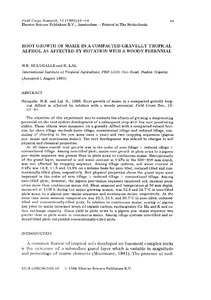| dc.description.abstract | The objective of this experiment was to evaluate the effects of growing a deep-rooting perennial on the root system development of a subsequent crop with low root penetrating ability. These effects were measured on a gravelly Alfisol with a compacted subsoil horizon for three tillage methods (zero tillage, conventional tillage and reduced tillage, consisting of chiseling in the row zone once a year) and two cropping sequences (pigeon pea-maize and continuous maize). The root development was related to changes in soil physical and chemical properties.
At all times overall root growth was in the order of zero tillage > reduced tillage > conventional tillage. Among zero-tilled plots, maize root growth in plots sown to a pigeon pea-maize sequence was greater than in plots sown to continuous maize. Macroporosity of the gravel layer, measured as soil water content at 0 kPa in the 500–600 mm depth, was not affected by cropping sequence. Among tillage systems, soil water content at 0 kPa was 18.9, 11.8 and 13.9% on a volume basis for zero-tilled, reduced-tilled and conventionally-tilled plots, respectively. Soil physical properties above the gravel layer were improved in the order of zero tillage > reduced tillage > conventional tillage. Among zero-tilled plots, however, the pigeon pea-maize sequence improved soil physical properties more than continuous maize did. Mean seasonal soil temperature at 50 mm depth, measured at 1400 h during the major growing season, was 32.8 and 34.7°C in zero-tilled plots sown to a pigeon pea-maize sequence and continuous maize, respectively. At the same time mean seasonal temperature was 33.8, 35.5, and 39.7°C in zero-tilled, reduced-tilled and conventionally-tilled plots. In relation to continuous maize, sowing of pigeon pea prior to maize increased levels of organic carbon, exchangeable Ca, Mg and K and cation exchange capacity. Grain yield in plots sown to a pigeon pea-maize sequence was greater than in plots sown to continuous maize. Among tillage systems zero-tilled and reduced-tilled plots outyielded conventionally-tilled plots. |

